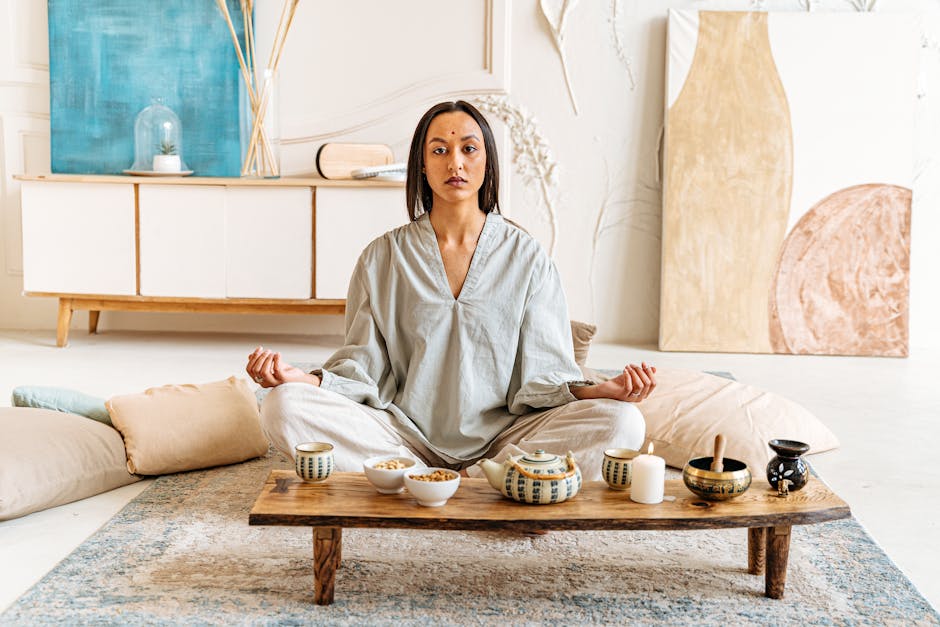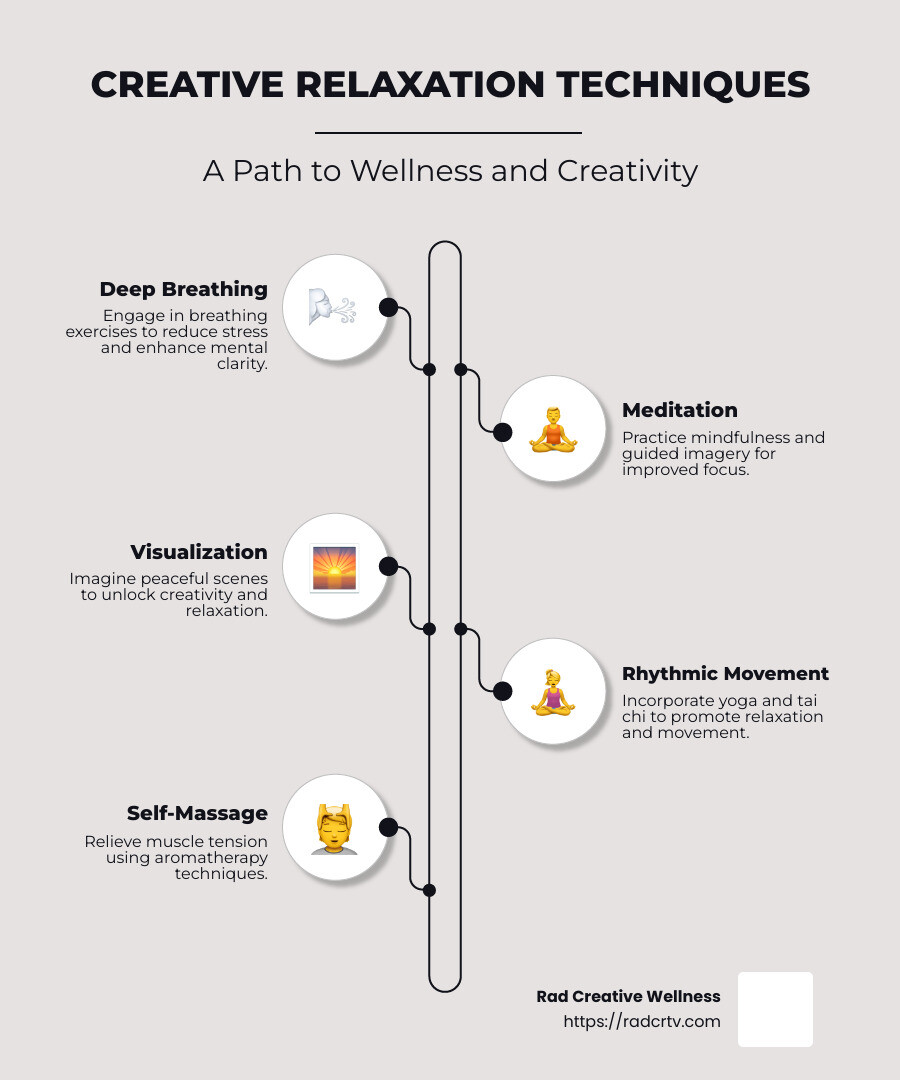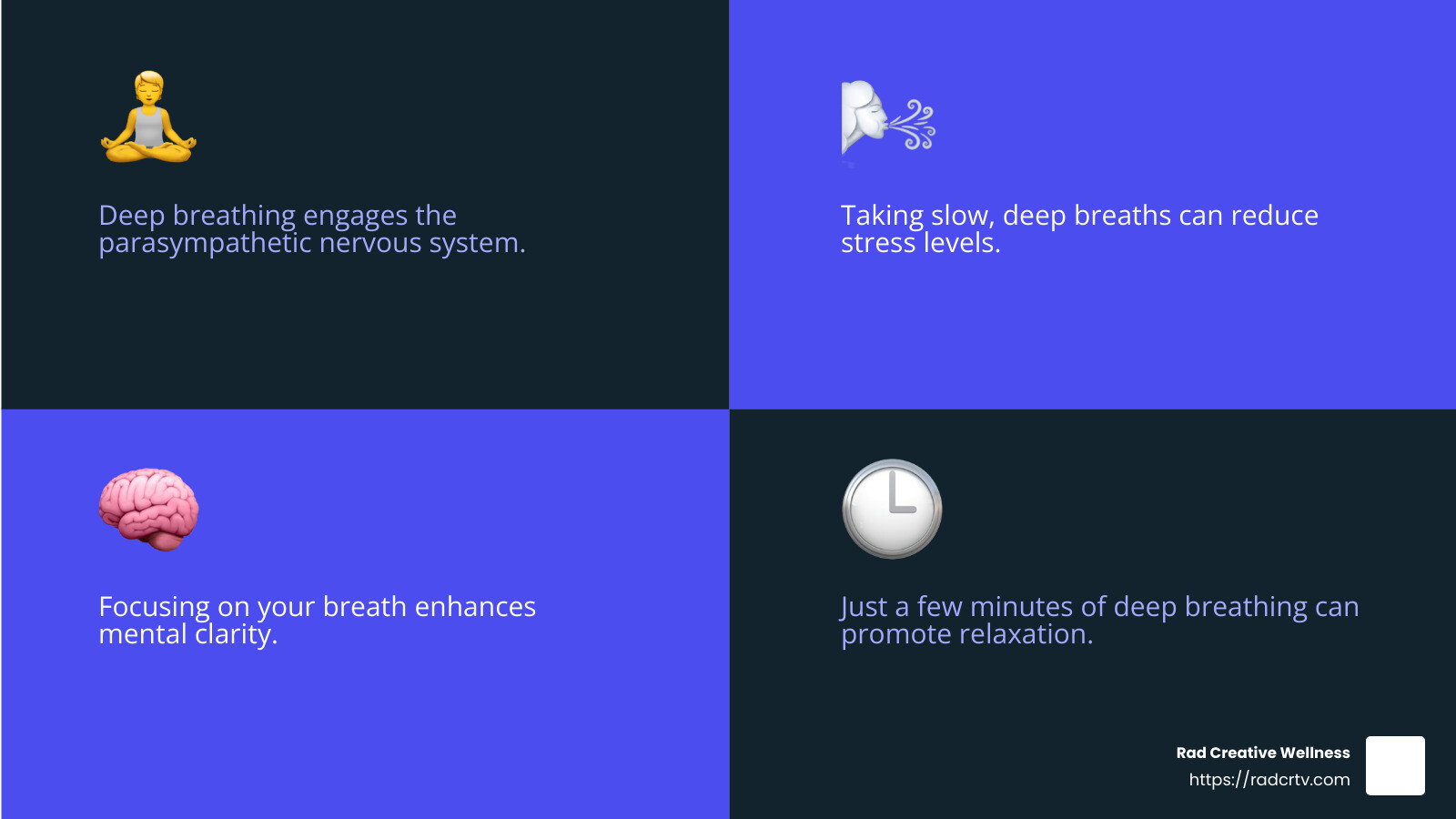
Breathe Easy: Innovative Ways to Relax and Unwind
|
|
Time to read 7 min
|
|
Time to read 7 min
Creative relaxation techniques are a game-changer for anyone feeling overwhelmed by life's demands. Imagine stress melting away as you dive into methods like deep breathing, meditation, and rhythmic exercises. Here's a quick peek at what these techniques can do for you:
In today's world, learning to manage stress is more important than ever. The secret to achieving a state of relaxation lies in engaging your brain in different, creative ways. When you're relaxed, the brain's "relaxation response" gets activated, opening a gateway to fresh ideas and solutions. So, whether you're meditating or taking a leisurely walk, relaxation doesn't just recharge you—it empowers you.
I’m Robert Resz, a passionate wellness expert dedicated to helping people relax and thrive using creative relaxation techniques. My journey into wellness has been about inspiring others to optimize their health and well-being with innovative strategies. Join me in exploring how these techniques can transform your daily life.
Must-know Creative relaxation techniques terms: - how to manage stress - stress management tools - what tools do you use to manage stress
Let's explore creative relaxation techniques that can help you unwind and recharge. These methods, including deep breathing, meditation, and rhythmic exercise, are not just about relaxation—they're about enhancing your overall well-being.
Deep breathing is a powerful tool for stress relief. It's simple, effective, and can be done anywhere. When you focus on taking slow, deep breaths, you engage your parasympathetic nervous system, which helps calm your mind and body.
Try this: Sit comfortably, close your eyes, and take a deep breath in through your nose. Let your abdomen expand as you inhale. Hold for a moment, then slowly exhale through your mouth. Repeat this cycle for a few minutes, and feel the tension melt away.
Meditation is another fantastic way to relax and boost your creativity. By practicing mindfulness meditation, you can clear your mind and focus on the present moment. This technique has been shown to reduce stress and improve mental clarity.
To get started, find a quiet space, sit comfortably, and focus on your breath. If your mind starts to wander, gently bring your attention back to your breathing. Even a few minutes of meditation each day can make a big difference.
Rhythmic exercises like yoga and tai chi combine movement with mindfulness. These practices not only improve physical health but also promote a sense of calm and balance.
Consider trying a beginner yoga class or a tai chi session. These activities involve gentle, flowing movements that can help reduce stress and improve your mind-body connection.
Incorporating these creative relaxation techniques into your routine can lead to a more relaxed, focused, and creative you. As you explore these methods, consistency is key. Regular practice can help you manage stress, improve your health, and open up your creative potential.
Deep breathing is a simple yet effective way to reduce stress. By focusing on your breath, you can calm your mind and body. This technique activates the parasympathetic nervous system, promoting relaxation.
Try this exercise: Sit comfortably, close your eyes, and inhale deeply through your nose. Let your abdomen rise as you fill your lungs. Hold your breath for a moment, then exhale slowly through your mouth. Repeat this process for a few minutes to feel the stress melt away.
Meditation helps you find peace and clarity. Mindfulness meditation, in particular, is about staying present and aware. This practice reduces stress and improves mental focus.
To start meditating: Find a quiet spot, sit comfortably, and focus on your breathing. If your thoughts wander, gently bring your attention back to your breath. Even a few minutes a day can make a difference.
Visualization involves creating peaceful scenes in your mind. This technique, also known as guided imagery, helps you relax by imagining calming places or situations.
Try this: Close your eyes and picture a serene beach or a quiet forest. Imagine the sounds, smells, and sensations. This mental escape can help reduce stress and promote relaxation.
Rhythmic movements like yoga and tai chi combine gentle exercise with mindfulness. These practices not only improve your physical health but also bring a sense of calm and balance.
Consider joining a beginner yoga class or trying tai chi. These activities use slow, flowing movements to release tension and improve your mind-body connection.
Self-massage can help relieve muscle tension and stress. Combined with aromatherapy, it becomes even more effective. Essential oils like lavender or chamomile can improve relaxation.
To try self-massage: Use your fingers to gently knead tense areas like your shoulders or neck. Add a few drops of essential oil for a calming effect. This simple practice can soothe both your body and mind.
Incorporating these creative relaxation techniques into your daily routine can help you manage stress and improve your well-being. Consistent practice is key to open uping their full benefits.
Incorporating creative relaxation techniques into your life can lead to numerous benefits, particularly for your mind and body. Let's explore some of these advantages.
When stress clouds your thoughts, it can be hard to focus. Techniques like deep breathing and meditation clear the mental fog. They help you find your center and sharpen your mind.
A study found that even short sessions of mindfulness meditation can boost creativity and clarity. Imagine being able to think clearly and come up with new ideas more easily, just by taking a few minutes each day to meditate.
Stress can make you feel irritable and angry. But relaxation techniques like self-massage and visualization can help you stay calm. These practices allow you to control your emotions better.
For example, visualization helps you imagine peaceful scenes, which can soothe your mind. By picturing a serene beach or a quiet forest, you can reduce tension and anger.
Good sleep is crucial for health and well-being. Stress often disrupts sleep, but creative relaxation techniques can help. Practices like rhythmic movement and guided imagery prepare your body for rest.
Engaging in yoga or tai chi before bed can relax your muscles and calm your mind. Visualization can also ease you into sleep by creating a mental escape from daily stressors.
By integrating these techniques into your routine, you can enjoy deeper, more restful sleep and wake up refreshed.
These benefits show how powerful creative relaxation techniques can be. They not only help you manage stress but also improve your overall quality of life.
When anxiety strikes, creative relaxation techniques can be incredibly helpful. Deep breathing is one of the simplest and most effective methods. By focusing on your breath, you can slow your heart rate and calm your nervous system. Try the 4-7-8 breathing technique: inhale for four seconds, hold for seven, and exhale for eight.
Mindfulness meditation is another great technique for reducing anxiety. It involves focusing on the present moment without judgment. Even a few minutes of mindfulness can help you feel more grounded and less anxious.
Guided imagery and visualization can also be beneficial. Imagine yourself in a peaceful place, like a quiet beach or a lush forest. This mental escape can reduce anxiety and promote relaxation.
Relaxation and creativity often go hand in hand. Meditation is a key tool for open uping your creative potential. As studies have shown, even short meditation sessions can improve creativity by clearing the mind and opening it to new ideas.
Rhythmic exercise is another way to relax and boost creativity. Activities like yoga or tai chi combine movement with mindfulness, helping you relax while sparking creative thoughts. These exercises encourage a flow state, where ideas can come more freely.
Visualization can also be a powerful tool for creativity. By picturing positive outcomes or new ideas in your mind, you can improve your creative thinking. This technique allows you to explore possibilities without limits.
The most effective relaxation technique can vary from person to person, but many find guided imagery and visualization to be particularly powerful. These methods allow you to mentally escape stressful situations by imagining calming scenes or positive scenarios.
Deep breathing is another universally effective technique. It’s easy to do anywhere and can quickly reduce stress. Whether you’re at your desk or in a crowded place, focusing on your breath can help you relax.
The best technique is the one that works for you. It might take some experimentation to find the right fit, but once you do, you'll have a valuable tool for managing stress and enhancing creativity.
At Rad Creative Wellness, we believe in the transformative power of integrating creativity and wellness. Our mission is to empower individuals to explore new dimensions of health through innovative and science-based practices. By combining creative relaxation techniques with proven wellness strategies, we offer a unique approach to stress management and overall well-being.
Creativity isn't just about making art; it's a powerful tool for enhancing mental clarity, reducing stress, and boosting overall happiness. Techniques like deep breathing, meditation, and visualization are not only effective for relaxation but also foster a more imaginative and open mindset. These practices help shift the brain from a busy, overworked state to a more relaxed and creative one.
As you start on your journey to better health, relaxation is a personal experience. What works for one person might not work for another, so explore different techniques and find what resonates with you. Our collection offers a range of resources to support your unique journey, providing tools and insights to help you integrate creativity into your wellness routine.
Incorporating these techniques into your daily life can lead to profound changes, improving not only your mental and physical health but also your creative potential. Here's to a more relaxed, creative, and fulfilled you!


